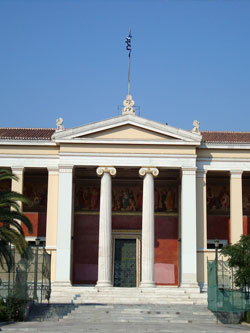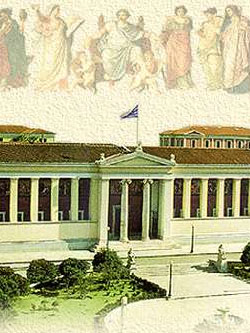

Old National University of Athens
The area with formal plantings between the Old National University of Athens building and Panepistimiou street has been restored to its former glory after the construction of the Panepistimio (University) Station of the Metro. The University was founded by loannis Kapodistrias after the creation of the Greek state in the late 1820s. The first building was in Ano Plaka at the Stamatios Kleanthis house. The building in Panepistimiou street was designed by Hans Christian Hansen and constructed between 1839 and 1842, with funds provided by various philhellenes and Greeks living abroad. The University moved here in 1843 and was called the Othonian University. After the deposing of King Othon in 1863 it was known as the National University, until 1912, when the generous benefactor Dombolis who left his fortune to the university stipulated that it be called the Kapodistrian University. Today the different faculties of the university are scattered around Athens and the suburb of Zografou, where the main, modern university campus (Panepistimioupolis or University City) is located on the lower slopes of Mount Hymettos. This Neoclassical building is now used for administration as well as for special lectures.
The building has an uppercase H-shaped plan. The southeast long side is fronted by a Pentelic marble portico in the Ionic order. Sphinxes served as the corner akroteria of the pediments. On the inner walls of this portico are frescoes designed by the Bavarian Karl Rahl and painted after 1888 by Eduardo Lebiedzky. They illustrate famous individuals and heroes associated with Greek art, education and mythology cavorting around King Othon' s throne as patron. Baron Simon Sinas funded this decoration. In the pediment of the entrance porch are painted sculptural personifications of the subjects taught at the university. Five statues stand in front of the building, with the British Prime Minister and politician William E. Gladstone (1886, marble by Georgios Vitalis [ 1838- 1901 ]) occupying pride of place in the center. The statues of the philosopher, scientist, teacher, poet, newspaper publisher and pre-revolutionary radical thinker Constantinos Rigas Pheraios of Velestino, marble, by loannis Kossos [1822-1875]; Rigas Pheraios was arrested by the Austrian police in 1798 and handed over to the Ottoman authorities, which then killed him by strangulation in the fortress in Belgrade and the Patriarch of Constantinople Gregorios V (1869-1872, marble, by Georgios Phitalis; he also was killed violently by an Ottoman mob in Istanbul, in protest after the outbreak of the War of Independence in 1821, thus, earned the title national martyr) stand in front of the lateral facades. The former Secretary of State of Russia under Czar Nicholaos and a hero of the War of Independence, Count loannis Kapodistrias and a famous Hellenist, philosopher and participant in the French Revolution, Adamantios Korais [ 1748-1833] (1875, marble, by Georgios Vroutos [1843-1909]) have seated statues on either side of the entrance steps. Korais was one of the key agents in attempts to reawaken a sense of the past by classical education, in order to free Greeks from the double oppression of the Turks and of the Church.
